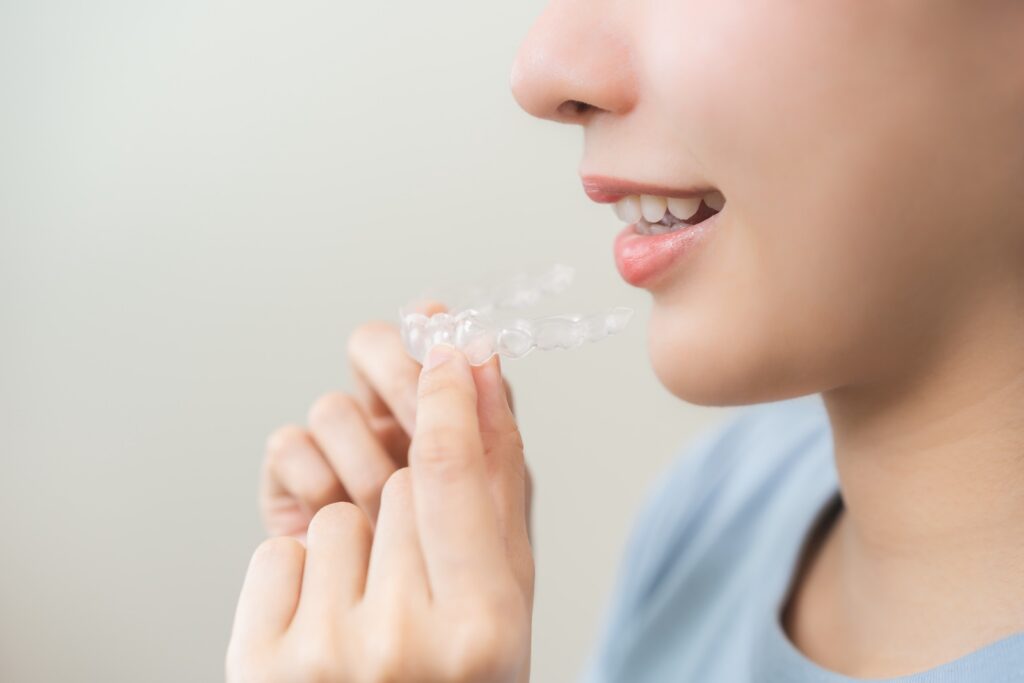
Straightening your teeth can be the first step towards enhancing your smile. Today, many people choose Invisalign to help them with this process because it’s discrete, removable, and convenient.
But like any dental procedure, Invisalign treatment still requires commitment and care. So, if you’re considering it, you may wonder how long treatment will take.
Invisalign treatment duration depends on various factors, from the severity and specifics of your dental issues to how consistently you wear the aligners.
Results may start being visible in just 6 months. In some cases, treatment can last for more than 20 months.
What Is Invisalign?
Invisalign treatment is a process that uses a series of clear, customized plastic aligners to shift your teeth slowly into a desired position.
Invisalign is generally meant to be worn for 20 to 22 hours daily, so you should only take out your aligners to eat, drink, brush, and floss. You will receive a new aligner every 1–2 weeks, and each aligner will help get you closer to your desired result.
Unlike traditional braces, Invisalign uses discrete, clear aligners. The aligners are also removable so that you can eat, brush your teeth, and floss without them getting in the way. Thanks to its subtle look and convenience, many people find the Invisalign approach appealing.
How Long Does Invisalign Take?
How long Invisalign takes varies from person to person, as each individual’s circumstances are unique. According to the makers of Invisalign, you can start seeing results in as little as 6 months.
However, a 2023 study of 500 patients in 2 clinics found that the average treatment time was 22.8 months, with some patients transitioning to traditional braces. Still, many people experience shorter treatment durations with clear aligners than with traditional braces.
Ask your dentist for a treatment time estimate that’s personalized for you. Because treatment time varies widely, focus on the factors you can control to help successfully complete your treatment. Ask your dentist for tips to support your treatment timeline.
Factors That Affect the Success of Invisalign Treatment
Your smile is one of a kind, and so is your Invisalign journey.
While you have control over some factors, like how well you follow instructions and how long you wear your aligners each day, other factors are a bit different for everyone, like how crooked your teeth are or the type of bite issue you have.
Let’s take a closer look at some of the key factors that can influence your Invisalign treatment timeline.
Dental Concerns
Invisalign may be less effective for those with more complex cases, such as severe misalignment and significant gaps. Traditional braces are versatile and typically more effective for complex or mild dental concerns.
Age
Kids, teens, and adults can all use Invisalign, but their experience may vary across ages.
For kids and teens between 9–14, their jaws and facial bones are still growing, which means they’re more flexible and can respond more easily to orthodontic treatment.
Research has suggested that adults in the 35–50 age range may experience faster tooth movement. So, Invisalign may work faster for adults in this age range.
Compliance
How successful your Invisalign treatment will be may depend on how consistently you wear your aligners.
You’ll generally wear your aligners between 20 and 22 hours a day. Only take out your aligners when you need to brush, floss, eat, drink, or clean your aligners.
You should also visit your dentist every 1–2 weeks for new aligners. Your dentist can provide personalized instructions about how often you should visit for check-ups and how many hours each day you should aim to wear your aligners.
Follow the recommended steps to protect your progress. Inconsistent follow-through might mean the treatment takes more time to complete.
Refinement
Keep in mind that your Invisalign timeline might take a little longer or shorter, depending on how your teeth, gums, and jaw are moving.
When you start Invisalign, your dentist will develop a treatment plan with predictions about your progress. However, sometimes, adjustments are needed along the way. Refinement is when additional rounds of aligners are needed to get teeth to their desired position.
Invisalign Tips

Want to support your Invisalign success? Follow these tips:
- Wear your aligners consistently according to your dentist’s instructions
- Attend scheduled check-up appointments & switch to your new aligner set as scheduled
- Take care of your aligners & avoid cleaning with hot water, which may warp the material
- Store your trays in a dedicated protective case to protect your aligners
- Brush your teeth before reinserting your aligners
Invisalign vs. Traditional Braces
Many people considering orthodontic treatment wonder which is more effective, Invisalign or traditional braces. The truth is that both options have benefits.
Generally, treatment with traditional braces takes about 2 years, but that can vary based on individual factors.
For some people, such as those with bridgework or more complex cases, Invisalign may not be suitable. Always have a thorough conversation with your dentist to explore your options.
Invisalign can offer many attractive advantages over traditional braces. The removable aligners make the trays (and your teeth!) easier to clean.
It’s also transparent and discreet, making clear aligners preferable for those conscious about their appearance in professional or entertainment settings.
See If Invisalign Is Right for You
Your dentist has a deep understanding of what makes your smile unique. A consultation is the ideal first step if you’re considering ways to enhance your smile.
At Generations Dental in Grande Prairie, we’ve been serving our community for over 30 years, and we’re genuinely passionate about creating happy smiles. Schedule an appointment with our team today to learn more about the benefits of Invisalign and other cosmetic dental services.


